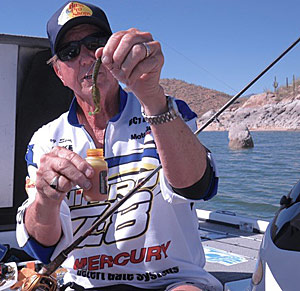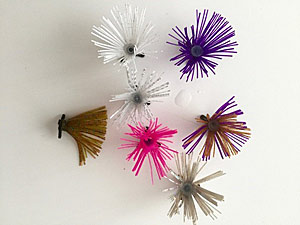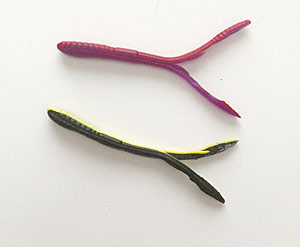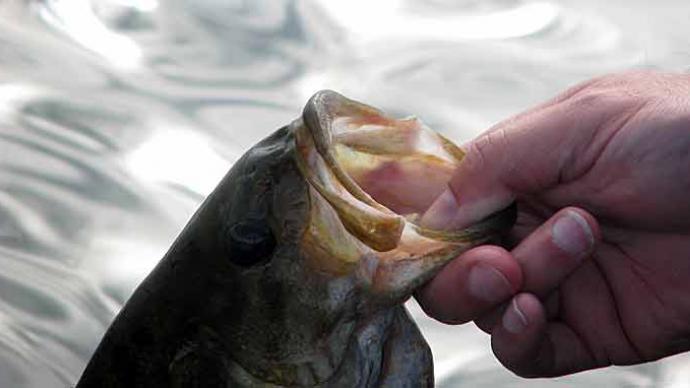
There are several definitions of the word “finesse,” but two are commonly thought of when a fisherman uses the words finesse bait or finesse fishing. The first definition is “intricate or refined,” and synonyms for this would be flair, panache, mastery, or expertise. The second definition is to do something subtly and delicately.
Most of the time, fishermen use a small plastic bait when finesse fishing, but that doesn’t mean you can’t add a little panache to the lure and still be finesse fishing – just fish that bad boy subtly and delicately. Adding panache to a finesse worm is easy, and it can help you put fish in the boat by adding just enough flair to get you noticed. Here are six ways to trick out your finesse baits.
Dye
Dye is one of the easiest ways to add a bit of bright color to a bait. Gary Senft, a Nitro pro based in Arizona, often uses Spike-It to brighten the tails on his finesse baits – not just worms. He fishes a lot of watermelon green baits in the big Western reservoirs, and dipping the tails in some chartreuse Spike-It not only makes his lures easier to see, but it also gives them a shot of scent that covers up his human smell. One of the reasons that he loves to dye his tails chartreuse is that it helps the baits to match one of the chief forage of the bass out west – sunfish.
These dyes are available in various scents and colors and cost less than $5 a bottle. The bottle lasts darn near forever, too. Spike-It also makes worm paint in a bunch of colors and scents. They also make a scented marker – so if you wanted to, you could zebra-stripe your bait or draw eyes on it. You should check their stuff out at ispikeit.com.
Ziptailz

Ziptailz are little skirts that simply slip over the hook before you put the worm on. They not only add a flash of color but also a subtle movement to your bait that you can’t get without a skirt. They add color, motion, and profile change in seconds. Eddie Johns of Alabama is a huge fan of Ziptailz and adds them to nearly every worm he fishes. It’s a super easy, fast way to make a color change without changing your worm.
Eddie sent me a bag of Ziptailz, and I tested them out on a very tough day on Bartlett Lake in Arizona. It was windy as all got out, it was hot (the water temp was 89!), and I was in the back seat. It doesn’t get much more challenging than that, right? The boater and I were fishing Texas-rigged worms, and I outfished him 3:1 using Ziptailz. That’s no exaggeration either – we counted every fish. The only difference was the Ziptailz.
They come in a wide variety of colors, and they are designed to fit treble hooks as well. The little rubbery thing that the skirt is attached to is unbelievably stretchy – it will stretch to fit a huge treble hook if you want it to. Ziptails are less than $3.50 for a package of two, and there are also ProPac kits with colors chosen by pros for specific species of fish. You get a better deal on the ProPacs. BTW, that little thing that lets you attach the ziptailz to a treble can be snipped off if you want, but I asked Eddie, and he says he doesn’t bother to cut them off, so I didn’t either so that you know.

Surgery
One of my favorite finesse baits is a superfloater worm. These worms are made with plastic that is injected with a lot of air, so they float in the water. I like to split-shot them – they float above the bottom, and when you give the line a twitch, they dart down as the split shot moves, then float back up. It’s killer.
Another way to fish them is on a pea head jig. I like to cast it to shore, let the line go slack, give it a pull, and let the line go slack until it reaches the boat. When you give it a pull, you’ve got a fish if it feels heavy. When I fish it this way, I take a pair of scissors and slit the tail right down the middle for a few inches. This makes those two halves wave around off the bottom and gives it the look of a craw.
Slitting the worm is a simple operation, but if you want to elaborate, you can get yourself a ProWeld Wormizer from my buddy Don Iovino and start customizing your baits. You can weld different colors together and add claws or tails – you name it. The Wormizer is just under $25; you can get it at iovino.com. You can also use the Wormizer to repair your baits when a big bass tears them up.
Heads
I refereed a Red Man All-American tournament one year and got drawn with a guy named Leroy Bertolero from California. He was not only a ton of fun to fish with (he has a million stories), he was a great source of all kinds of information. One of the things I remember most is how he customized his jig heads. Leroy would take a lead pea head jig, then use a hammer to flatten the sides. This makes the jig swim through the water smoothly and gives you two wonderful surfaces to attach your eyes to. Leroy used those plastic googly eyes you can get at the craft store. A bonus – those things add a bit of sound to the bait.
There are also plenty of pre-printed eyes that are designed for baits (so they don’t float off under water), or you can paint them on. You don’t have to paint your eyes, either. You could simply paint the jig head the color of your choice. Either way, this is great to gussy up a plain pea head and add some pizzazz to your baits. If you’re not the crafty or artistic type, many brands of already painted and decorated jig heads are out there. It’s just a lot cheaper to DIY.
Blood
I knew a fisherman in Arizona who told me it would take an 18-wheeler to hold all his tournament trophies. That may or may not be accurate, but I must admit that the guy is one heck of a stick. He had one thing that he did consistently, no matter what bait he was fishing. He added red. It didn’t even have to be a lot of red – he’d dab a spot of red paint on a spinnerbait head or a crankbait or dip his worm in red Spike-It. There’s a one straightforward way to add just a sliver of red to every worm you fish – use a red hook. Just tie one on, and every worm you put on that thing will look like it’s bleeding. You can get red hooks just about anywhere; the only drawback is that the red might start wearing off after a long time—a small price to pay.
Sound
There are a variety of ways that you can add sound to your finesse worm. You can add rattles by inserting them into the worm or fish them on a rattling jig head. Even propellers slide in front of your worm to move water around, and a bass detects water movement as sound.
Gary Senft likes to use tungsten bullet weights when he Texas-rigs a finesse worm – they make a sharper clicking sound when they hit rocks. Another way to add sound to a lure is by letting it make a splash when it hits the water.
These are just ways to add movement, color, sound, and flash to a lure to get a bass's attention. Let’s face it: a bass can’t eat what he can’t find. Use these techniques to get found.
BassResource may receive a portion of revenues if you make a purchase using a link above.




